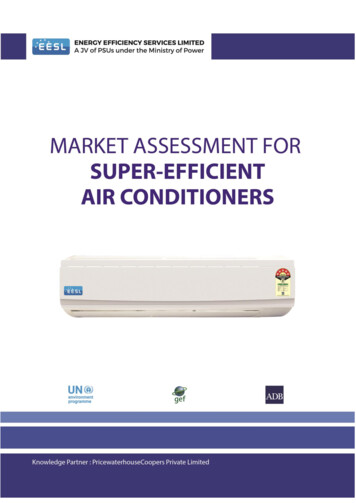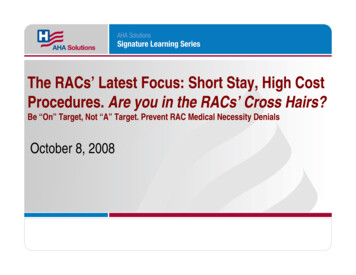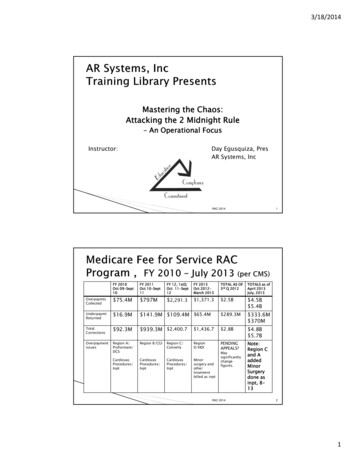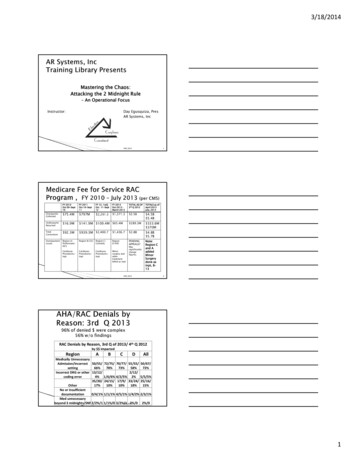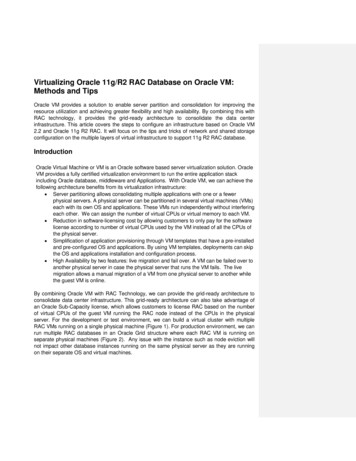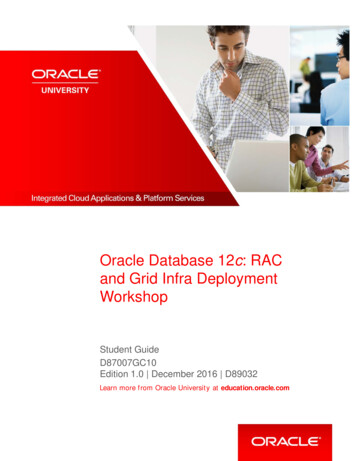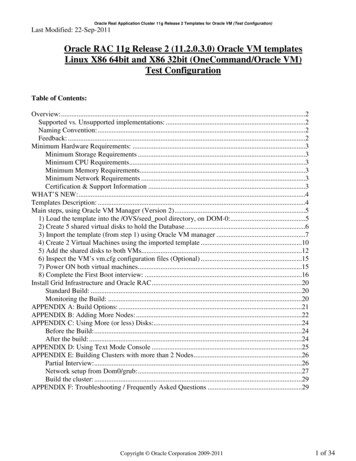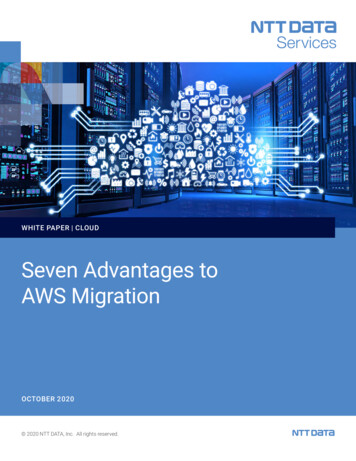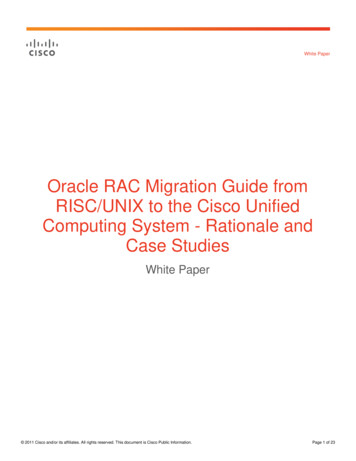
Transcription
White PaperOracle RAC Migration Guide fromRISC/UNIX to the Cisco UnifiedComputing System - Rationale andCase StudiesWhite Paper 2011 Cisco and/or its affiliates. All rights reserved. This document is Cisco Public Information.Page 1 of 23
What You Will Learn . 3Overview. 3Changing Server Economics and Market Share. 3New Demands on Data Center Architectures . 5Case Study: EMC IT Migrates from RISC/UNIX to the Cisco Unified Computing System . 7Deployment and Testing of Oracle RAC Database Servers . 8Migrating the Oracle CRM Database . 11Migrating the Sun SPARC Server to an x86 and Linux Cisco UCS Server. 11Lessons Learned in the Move to the New Platform . 12Oracle Lessons Learned. 13EMC IT’s Oracle Best Practices. 13Results from the EMC Migration . 14Case Study: Cisco IT Migrates from Traditional HP-UX Platforms to the Cisco Unified Computing System 15The Oracle Migration . 15The SAP Migration. 16Migration Results . 18Lessons Learned in the Move to the New Platform . 20Cisco Unified Computing System: Benefits and Differentiators During Migration and Beyond . 20The Cisco Advantage . 22Conclusion . 22For More Information. 23 2011 Cisco and/or its affiliates. All rights reserved. This document is Cisco Public Information.Page 2 of 23
What You Will LearnA massive shift is underway in the underlying computing architecture and platforms used to run enterpriseapplications. Traditional RISC/UNIX server platforms have not kept pace with current demands for fasterapplication deployments, flexible and simpler provisioning, and cost-effective licensing, support, and management.The industry has moved on, as the diminished value of RISC/UNIX systems has been widely acknowledged. The Cisco Unified Computing System (Cisco UCS ) provides innovative architectural advantages that simplify andaccelerate deployment of enterprise-class applications running in bare metal, virtualized, and cloud computingenvironments. Cisco UCS offers an alternative server architecture to RISC/UNIX, based on the lower-cost, highperformance x86 processor. This document discusses the factors that contribute to the lower total cost ofownership (TCO) of Cisco UCS and the platform’s unique features and product components. The document alsoincludes two case studies that demonstrate the migration to Cisco UCS from traditional server environments bytwo of the largest IT environments in the world, hosting large, mission-critical applications: EMC IT and Cisco IT.OverviewJust as the microprocessor has become smaller, more powerful, and more cost effective over time - boosting thecapabilities and performance of the devices and applications it enables - the server environment that runsbusiness and infrastructure applications has moved to a new state of the art. Since the mainframes in the 1960sand 1970s and the minicomputers and client-server architectures in the 1980s, the server design of choice forboth general and mission-critical application workloads from the mid 1990s to the early years of the twenty-firstcentury has been based on reduced instruction set computer (RISC) processor architectures, mostly running UNIXoperating systems.These server platforms have been tremendously successful, providing reliability, availability, scalability, and manyother features required of the most demanding computing environments. But now a new generation of servers,based on the x86 processor architecture and open standards operating systems such as Linux, have caught upwith RISC/UNIX server platforms. Within this new generation, Cisco Unified Computing System is a highly uniquex86-based server architecture and product line that many large customers have found offers features andefficiencies that meet enterprise-class levels of reliability, availability, and serviceability (RAS) while providingfaster, simpler, more agile application deployment.Cisco UCS is proving itself in some of the largest, most demanding application environments in the world. It isbecoming a ubiquitous platform as part of solutions from Oracle, SAP, BMC Software, Citrix, EMC, Microsoft,NetApp, Red Hat, and VMware. In addition, it is positioned to coexist with RISC infrastructure, to host traditionalUNIX applications, and to serve as a versatile and dynamic solution for cloud computing and data centerconsolidation. Less than two years since its introduction, Cisco UCS has 10 percent of the global x86 market and20 percent of the U.S. market, according to IDC. More than 42 technology partners have integrated theirmanagement platforms with Cisco UCS APIs.Changing Server Economics and Market ShareOne of the reasons behind the mass migration now underway to the x86 server architecture is the greatly reducedTCO of x86 systems (Figure 1) in comparison to the high acquisition, maintenance, environmental, and licensingcosts of RISC/UNIX systems. RISC/UNIX systems have a larger footprint, increasing space requirements, andhigher power and cooling costs, all also components of TCO. 2011 Cisco and/or its affiliates. All rights reserved. This document is Cisco Public Information.Page 3 of 23
Figure 1.TCO Comparison of x86 Server Blade and RISC/UNIX Tower ServerSource: CiscoAdditional factors behind the move from RISC/UNIX to x86 servers include: Savings in operating costs: Maintenance of traditional RISC/UNIX systems requires costly staff and trainingfor new hires, many of whom come out of school having worked on and studied x86-based serverarchitectures. Virtualization has increased geometrically the number of logical servers being managed, andthis has contributed to soaring costs for server management and administrative labor. Althoughvirtualization can eliminate the need for many new servers, it aggravates the management problem in atraditional environment. Unclear future for RISC: RISC systems have an unclear future because of the move to x86. Fewerapplications are being developed for RISC systems due to a declining software ecosystem, and existingapplications have longer lead times for updates and new capabilities along with premium prices due to adeclining skill base. Demand for increased processing power: Mission-critical workloads are increasing, and traditionalRISC/UNIX systems are difficult and expensive to scale. Complexity of traditional systems: RISC/UNIX systems have many distinct components that must beintegrated and many different points of system management, resulting in a high degree of complexity thatis compounded with new applications, enhancements, and scaling. 2011 Cisco and/or its affiliates. All rights reserved. This document is Cisco Public Information.Page 4 of 23
Shift from scale up to scale out: Mission-critical workloads are now being redesigned to scale out acrossmultiple smaller servers, rather than scaling up monolithically through the addition of RISC/UNIX serverclusters. This scale-out design enables much greater flexibility in application workload distribution and ahigher utilization rate for server resources. The main factors influencing this trend include virtualization,cloud technologies, and server clustering.It is therefore no surprise that deployment of servers based on RISC/UNIX architectures has dramatically declinedwhile deployment of x86-based products has grown (Figure 2).Figure 2.Server Revenue by CPU ArchitectureSource: IDC Q4 2010 Server TrackerAmid mixed signs of a global economic recovery, IDC charted the growth of the server market and found that x86server sales were up 17 percent in 2010 while RISC server sales declined by 18 percent. Customers runningOracle applications on RISC-based SPARC servers with the Sun Solaris operating system have become waryabout an uncertain roadmap since Oracle purchased Sun and has announced long release schedules forupgrades and a newer Linux offering for hosting Oracle applications.New Demands on Data Center ArchitecturesProduct vendors have long been familiar with just-in-time manufacturing and time-to-market as measures ofefficiency. Now application services - which enable new business capabilities to support strategic initiatives andare deployed in response to competitive challenges - are being similarly measured. IT departments are looking atthe relative agility of their computing environments: the capability to quickly deploy, modify, and scale applications.What they see are rigid, inflexible traditional computing environments that have not kept pace with demands forspeed, capacity, and scale.Today’s traditional and still predominant data center architecture contains separate, individual computing,networking, and storage components. Provisioning, integration, and modification of applications are generallyhandled manually. These time-consuming tasks reduce the amount of time administrators have to devote to otherinitiatives. A Forrester study in 2008 found that more than 70 percent of IT budgets is devoted simply tomaintaining and managing existing infrastructure, and this problem may have become even worse since then. 2011 Cisco and/or its affiliates. All rights reserved. This document is Cisco Public Information.Page 5 of 23
Many data centers have focused on consolidating their physical servers using virtualization to improve serverutilization. But virtualization of traditional server and storage hardware has added new complexity and challengeswhen used with old infrastructure, including: Overwhelmed RISC/UNIX server capacities: RISC/UNIX and other older servers based on traditionalprocessor technologies cannot achieve the desired workload scalability, are typically memory and I/Oconstrained, and use excessive power. The resulting capital expenditures (CapEx) and operating expenses(OpEx) required to maintain an aging server farm can quickly grow out of control. Many environments arefacing server hardware and software that is approaching the end of its life. Reduced cost effectiveness: RISC/UNIX acquisition and maintenance costs have become an increasinglysignificant component of IT costs. Not only are these platforms expensive to purchase, but maintenancecosts are high and per-core software licensing puts RISC/UNIX systems at a disadvantage. Inability to meet needs for performance and flexibility: Businesses are faced with increasing amounts ofdata to process and growing numbers of users wanting access to the data. The demands for additionalperformance are frequent and unpredictable. Today’s aging and proprietary RISC/UNIX infrastructure doesnot provide the performance or the flexibility required to support rapidly changing business requirements,and the cost to provide additional performance is high. With data centers moving to cloud computing, theneed for standard, nonproprietary platforms and solutions is even greater. An uncertain future: The installed base of RISC/UNIX systems in many organizations is ready to bereplaced or refreshed, prompting either wholesale upgrades or migrations to better platforms. Historically,the RISC/UNIX platform was the best option for mission-critical applications. Today, however, RISC/UNIXservers may no longer be the only option. Since 2006, the RISC/UNIX market has declined by 46 percent,according to the IDC Q4 2010 Server Tracker study. Processor roadmaps have been changed, delayingthe release of newer, faster capabilities. For example, SPARC processor release dates have been missed.In addition, with the acquisition of Sun by Oracle, SPARC customers must weigh the risk that Oracle’sfocus on appliances may increase the risk of vendor lock-in. High costs of technology silos: Current infrastructures contain separate silos of computing, networking, andstorage technologies. Deployment of virtualization in this infrastructure can lead to incremental increases inCapEx and OpEx because each silo must be addressed separately. Complexity of server management: Every traditional rack-mount or blade server and chassis constitutes aseparate point of management, with its own unique identity and I/O configuration that is tied to thehardware. This complexity limits the capability to respond quickly to workload changes. Server, blade,switch, and chassis firmware updating is a manual and time-consuming process. Network complexity and fragmentation: The network access layer has fragmented into multiple levels,including access-layer switches, switches integrated into blade chassis, and software switches required byvirtualization software. Each switch has its own unique set of features and limitations that add new layers ofmanagement and management domains to an already complex environment. Virtual server sprawl: The ease of deploying virtual machines has resulted in a significant increase in virtualmachine populations. These virtual machines create a new set of management challenges. The increasingnumber of components in data center environments has evoked a proliferation of management tools,making network policy difficult to track and to enforce. This sprawl increases the difficulty of ensuring thatserver, storage, and network resources adhere to the same standards as the servers and operatingsystems in traditional architectures. 2011 Cisco and/or its affiliates. All rights reserved. This document is Cisco Public Information.Page 6 of 23
Higher SAN costs: Shared storage is a requirement for many of virtualization’s most valuable features,such dynamic virtual machine movement and high availability. Providing access to a Small ComputerSystem Interface over IP (iSCSI) or Fibre Channel SAN for every server in a rack dramatically increasesthe number, costs, and administration of cables, adapters, and upstream switch ports. Growing power and cooling costs: The growth of in the number of physical servers, coupled withdramatically increasing demand, has increased power and cooling costs and effects on the environment. ITdepartments are looking for the highest performance with the lowest energy requirements in newcomputing solutions, as green initiatives and regulations proliferate throughout the world. Improved spaceand power utilization can postpone or prevent expensive new data center build-outs.IT departments are already beginning to migrate infrastructure applications (file server, mail server, print server,etc.) to x86 server architectures to take advantage of their expanded features, higher performance, and better costefficiency (Figure 3).Figure 3.Server Distribution by Application TypeSource: IDC, 2008The next step is the migration of large, business-critical applications. These applications include software solutionsfrom such vendors as Oracle, SAP, and IBM that may rely on middleware components, along with customapplications for specific industries and the newest application architectures for access using the network cloud.Case Study: EMC IT Migrates from RISC/UNIX to the Cisco Unified Computing SystemBetween 2009 and 2010, the IT department of global storage vendor EMC migrated its Oracle 11i E-BusinessSuite customer relationship management (CRM) solution from Sun Enterprise 25000 servers based on ScalableProcessor Architecture (SPARC) - a RISC variety - running the Oracle Solaris (a UNIX variety) operating system toCisco UCS based on x86 and Linux. The migration included deployment of Oracle Real Application Clusters(RAC) to create a database grid that could scale horizontally with the addition of more Oracle RAC nodes. 2011 Cisco and/or its affiliates. All rights reserved. This document is Cisco Public Information.Page 7 of 23
The goal of the migration was to move to a more open computing platform that would enable EMC to: More easily deploy applications on a private cloudTake advantage of CapEx and OpEx savings from reduced software and hardware maintenance, softwarelicenses, general support, and environmental costs in the data center Transition from Sun SPARC platforms that were approaching the end of lifeAfter evaluating several options for a next-generation computing platform, EMC decided to move to a new platform using Cisco UCS. EMC chose the Cisco system because of Cisco, EMC, and VMware’s mutual commitment to virtualization and Vblock Infrastructure Packages. Choosing a new platform was only the beginning. Migrationfrom SPARC to Cisco UCS was going to be a complex effort. An aggressive timeline also made a smooth cutoverto the new platform, with no impact on EMC’s business, critical.The EMC CRM system supports 40,000 users worldwide, with up to 4000 concurrent users during peak periods.The implementation is one of the top four Oracle transactional applications deployments in the world in terms ofscale and volume.Prior to the migration, EMC IT completed three preliminary projects to prepare their CRM infrastructure: Virtualization of the EMC CRM middle-tier infrastructure: Servers were transitioned from 71 physicalservers to 80 virtual machines on eight VMware ESX servers. Virtualization of Oracle E-Business Suite implementation: The Oracle E-Business Suite Release 12 (R12)applications stack was virtualized using VMware on x86 infrastructure running Linux. Migration from traditional business intelligence and data warehouse applications: The applications weremoved from a traditional Fujitsu platform running Solaris to an open platform running x86 and Linux onCisco UCS with an expandable infrastructure. The infrastructure is based on a consolidated physicalOracle RAC and Business Intelligence grid that supports EMC’s virtualized business intelligence toolsetreporting architecture based on VMware, Oracle Business Intelligence Enterprise Edition (OBIEE), andOracle Business Intelligence Publisher (BIP).Those initial projects gave EMC IT a deeper understanding of critical considerations for the migration, includingdetails related to the people, processes, and technologies required for migration to an open, scalable platform.In autumn 2010, the Cisco Advanced Services Unified Computing Architecture team engaged with EMC IT toassist with the migration. The architecture used a standard Cisco UCS configuration with little or no customization,a high-availability design with no single point of failure within the data center, and a maximum I/O throughput of80 Gbps per chassis for the fabric interconnect and external fabric. Fabric extender and fabric interconnect cablingwas increased for oversubscription to 80 Gbps, and Fibre Channel capabilities were expanded with a six-portexpansion module. As a foundation for a cloud architecture, the design provided the flexibility to add or removeCisco UCS computing and I/O fabric components, both external and interconnected.Deployment and Testing of Oracle RAC Database ServersOracle RAC allows database management systems to be scaled incrementally, using lower-cost two-socketservers instead of more expensive four-socket servers. This approach allows data warehouses to scale as thebusiness grows, starting small and growing as needs dictate. 2011 Cisco and/or its affiliates. All rights reserved. This document is Cisco Public Information.Page 8 of 23
The capability to easily, efficiently, quickly, and cost effectively scale a data warehouse is crucial for businessesthat depend on database applications. Scalability is achieved by adding units of computing power and hopefullyachieving a commensurate improvement in capacity. With traditional symmetric multiprocessors, however, as theinfrastructure scales, the performance and capacity per incremental resource declines. This decline occursbecause of the increased overhead of communications and data transfer between the different data warehouseelements and the increased latency (for example, when multiple, simultaneous queries to a database areprocessed), resulting in lack of access for some users for periods of time.Server provisioning is another challenge that can hinder easy, fast, efficient data warehouse scalability. As eachserver is added, it must be individually configured, a cumbersome and time-consuming process. The server’soperating system and firmware on the network card, Fibre Channel host bus adapters (HBAs), BIOS, and otherelements must be loaded. In addition, the network connection must be manually configured.Cisco UCS provides a better, faster, more cost-efficient and scalable server architecture for Oracle datawarehouses because it unites networking, computing, and virtualization resources into a cohesive system thatsimplifies setup, improves business metrics, and enables just-in-time resource provisioning. Six x86-based CiscoUCS B440 M1 High-Performance Blade Servers were deployed and configured using Oracle RAC to protectagainst physical node failure during the migration, with four ultimately used in the environment. The Oracle clusteris designed to function with more or fewer than six blades, but in the event of an extended blade outage or theneed for additional short-term computing power, a failed Cisco UCS server profile can be used to configure anadditional blade from the pool.The six-server chassis is spread across three cabinets, with each cabinet having redundant power feeds. EachCisco UCS B440 blade server has dual converged network adapter (CNA) cards, each presenting multiplenetwork interface card (NIC) and Fibre Channel over Ethernet (FCoE) devices. The public and interconnectedNICs are further protected with the N 1 interfaces on each server and are configured with Linux bonding.Access to the storage devices is also protected using N 1 Fibre Channel interfaces on each server, and these areconfigured with EMC PowerPath to protect against a CNA card or port failure. Each server boots from mirroredSAN devices.The major benefits of Cisco UCS for EMC include: Lower CapEx: No additional power cables, connectivity wiring, patch panels, Ethernet ports, powersupplies, or physical rack space are needed. Lower OpEx: Electricity consumption is lower, hardware support contracts are less expensive, and noonsite repair or installation visits are needed. Lower energy consumption: A typical Cisco UCS server blade draws 300 fewer watts of power than atypical, RISC/UNIX tower server. No additional hardware support contracts: The hardware support services for the networking devicestypically cover hardware support for the Cisco UCS server as well. Fewer onsite visits: Upgrading or replacing a Cisco UCS server is a simple “plug-and-play” process thatdoes not require a senior administrator or specialized skills. A costly onsite visit is replaced by a shippingcost. Enhanced platform for future growth: High-performance, high-capacity, general-purpose Cisco UCSservers allow customers to scale with changing business needs. 2011 Cisco and/or its affiliates. All rights reserved. This document is Cisco Public Information.Page 9 of 23
Improved use of hardware: Some Cisco UCS x86 server blades can be used as alternatives to rack ortower servers and as platforms for deploying branch-office networking applications. If businessrequirements change, these servers can quickly be repurposed without costly onsite visits.The new environment, shown in Figure 4, from right to left, includes: Six Cisco UCS 5108 Blade Server Chassis fully configured with Cisco UCS 2104XP Fabric Extenders. Fourteen Cisco UCS B200 M1 Blade Servers (half-width, 2-socket, 4-core Intel Xeon x5680 processor,2.93 GHz, 130W, 8-MB cache, and 96 GB of memory using twelve 8-GB dual inline memory modules[DIMMS]). Twelve Cisco UCS B440 M1 High-Performance Blade Servers (full-width, 4-socket, 8-core Intel Xeonx7560 processor, 2.26 GHz, 130W, 24-MB cache, and 128 GB of memory using thirty-two 4-GB DIMMS). Twenty-eight 2-port 10-Gbps Cisco UCS M81KR Virtual Interface Cards (VICs). Four 2-port, 10-Gbps Cisco UCS M71KR-E Emulex CNAs. Two Cisco UCS 6140XP 40-Port Fabric Interconnects. Two Cisco Nexus 7000 18-Slot Switches (LAN switches), to be shared with other domains through separate virtual LANs (VLANs). Two Cisco Nexus 5020 Switches (aggregation-level switches) that connect to Cisco UCS 6100 SeriesFabric Interconnects for backup SAN traffic and network-attached storage (NAS) devices. Two Cisco MDS 9513 Multilayer Director SAN switches, to be shared with other domains through separatevirtual SANs (VSANs). One EMC Symmetrix Virtual Matrix Architecture (V-MAX) System with four engines for production. One EMC Symmetrix V-MAX System with four engines for development, testing, and performance.Figure 4.EMC Migration to Cisco UCS: Production InfrastructureThe EMC Symmetrix V-MAX storage array was configured to include 450 devices, including enterprise flashdrives, Fibre Channel, and SATA drives. The disk format was RAID 1 and RAID 5, with concatenatedmetavolumes. SAN connectivity was enabled in an 8-Gbps infrastructure and 4-Gbps Fibre Channel connection tothe SAN. 2011 Cisco and/or its affiliates. All rights reserved. This document is Cisco Public Information.Page 10 of 23
Migrating the Oracle CRM DatabaseEMC used two methods to move the database to the new platform: Import and export: Data was imported into the appropriate tier according to performance characteristicsand the significance of the data. After the data was imported, a team validated the data while the data wasreplicated and exported to the production cluster using Symmetrix Remote Data Facility (SRDF). Transportable tablespaces: The Oracle Transportable Tablespaces (TTS) feature allows users to move anonsystem tablespace across Oracle databases. It provides an efficient and much faster way to move bulkdata between databases than does performing either an export-and-import or unload-and-load operationfor the same data because transporting a tablespace requires only the copying of data files from the sourceto the destination and then integrating the tablespace structural information.Migrating the Sun SPARC Server to an x86 and Linux Cisco UCS ServerEMC migrated the Oracle 11i E-Business Suite CRM application from UNIX to Linux using the recovery manager(RMAN) data file conversion feature (Figure 5).Figure 5.Oracle 11i CRM Database MigrationEMC IT chose to use Network File System (NFS) protocol mounting of the source logical unit numbers (LUNs).This approach allowed EMC IT to migrate the data files without having to first stage them in temporary storage inthe new cluster. Copying 8 terabytes (TB) of database files can take more than 12 hours to complete, so this stepremoved hours from the migration process. A more efficient method would have been to mount the actual LUNsdirectly for the new cluster. However, since the source file system was Veritas, EMC IT chose not to do this, due tothe expense of the license. This decision cost some valuable time, because the NFS protocol was a bottleneck.Here are the main database migration steps: On the source, mark the tablespaces in the transportable set as read only. Create a transportable tablespace for Oracle E-Business Suite (standard and custom) schemas and helpensure that violations are addressed. From the source, export the transportable tablespace metadata for all schemas except sys, system, andsource. (Note: Apply expdp patches 6354875, 5249074, and 5120780 on the source to improveperformance. Confirm that patch 6730429 is applied on the target before starting the impdp process there;the absence of this patch can cause loss of the database.) 2011 Cisco and/or its affiliates. All rights reserved. This document is Cisco Public Information.Page 11 of 23
From the source, export the Oracle E-Business Suite APPS user, miscellaneous data (package sequencesand procedures), and resource list server (RLS) policies for the full database. Note the assignment queueinformation from dba queues to restart the queues later on the target system. Export the SYSTEM schema and global temporary tables. EMC IT used RMAN to convert each data file. RMAN was needed
Oracle applications on RISC-based SPARC servers with the Sun Solaris operating system have become wary about an uncertain roadmap since Oracle purchased Sun and has announced long release schedules for upgrades and a newer Linux offering for hosting Oracle applications. New Demands on Data Center Architectures
